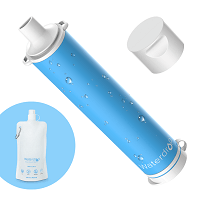With a portable water filter, you can purify water on the go. Portable water filters are compact devices with built-in filtration systems for removing water contaminants, including sediment, debris, and microorganisms; these filters are ideal for several situations, including traveling, camping, and survival. Water filters turn contaminated water into safe drinking water in a few steps.
What Should You Consider When Choosing Portable Water Filters?
When shopping for a portable water filter, the first factor to consider is its intended use. For camping and hiking purposes, the intended use of a water filter is to filter sediment and bacteria. For traveling abroad, its intended purpose will be to target viruses and bacteria. Other factors to consider when choosing water filters include the filter type, capacity, durability, size, and ease of use.
Filter Type
There are different styles when it comes to portable water filters, and they each have their setting. The popular water filter types are UV, gravity, straw, bottle, and pump filters.
Straw Filters
Straw water filters are not only portable, but they are also efficient and convenient. Just like regular straws, all you need do is stick one end of the water filter and take a sip. The straw filters water as it passes through, removing contaminants like bacteria, protozoa, and dirt and giving you safe, clean water.
Bottle Filters
Bottle water filters are excellent options for camping and traveling. The bottles carry and filter water. Usually, there is a straw filter that cleans water while you drink. In addition, bottle filters are portable, reusable, and great for daily use.
Gravity Filters
Gravity filters have one or two containers. When using gravity filters, fill one of the containers with dirty water while gravity moves the water through the filter. You can either filter the water into the second container or drink straight from a nozzle. Generally, gravity filters are not as portable as straw and bottle water filters because they are larger. Nevertheless, gravity filters have higher capacities.
Filter Size and Weight
The portability of a water filter depends on its size and weight. Also, the size of a water filter depends on its intended use. Straw water filters are compact and are ideal for personal use, while gravity filters are more suitable for group camping trips.
Filtration Speed
Although some portable water filters clean water instantly, others take longer. Flow rate is used to measure filtration speed. Flow rate is the amount of water that flows through a filter for a period, usually one minute.
Durability And Maintenance
The durability of a water filter is essential. A high-quality water filter should be able to withstand consistent use. Durability is important for camping trips and survival situations. Plastic materials are more common because it is lightweight, shatterproof, and easily portable.
Portable water filters need regular maintenance, including cleaning clogs, charging the filter’s battery source, and changing the filter. Disinfecting, washing, and back-flushing the filtration system are also ways of maintaining water filters. Fortunately, each manufacturer specifies the processes and frequency of maintenance and cleaning. Because your mouth is in direct contact with the product when using filtered straws and water bottles, you must wash them daily.
Our Top Water Filter Picks
You can have access to clean drinking water in any situation if you have a high-quality portable water filter. Moreover, portable water filters are compact, reliable, and easy to use. Below, we discuss the best portable water filters that provide clean drinking water on the go, including space-saving straws and high-capacity gravity filters.
portable water filter straws are compact. They can fit easily in carry-on bags or day packs. The Waterdrop lightweight filtration straw is a great companion for all your adventures. The filter straw has a 0.1-micron hollow fiber membrane that effectively removes almost all harmful substances in water. Furthermore, the filter has a high-grade coconut shell activated carbon fiber used for improving water taste and odor; it also ensures water safety, delivering a good drinking experience. You can drink without worry from streams, rivers, lakes, ponds, and glaciers.
The filter straw has a double-sided removable cap which is designed for different purposes. A waterdrop water filter straw achieves multiple water filtration functions. When filtering water for drinking, you should use the straw with water bags or water bottles. Because of the numerous ways of using it, a filter straw can achieve the same functions as personal water filters. You can either connect the filter straw to a water bottle or to a water bag to filter water. Furthermore, you can disassemble both ends to connect with water bags or water bottles, providing you with clean drinking water on the go.
Survivor Filter Pro – Hand Pump Camping Water Filter
the Survivor filter is a hand-pump water filter that can handle survival situations. This filter has a triple filtration system that rids water of sediment, protozoa, bacteria, viruses, and parasites. Furthermore, the filter reduces heavy metals concentration, unpleasant odors, and taste.
The filter is portable, not larger than the palm of a hand, making it convenient to carry. It also has a long water inlet and a separate water outlet hose that pumps water from shallow streams and deep rivers. Furthermore, the pump has a filtration capacity of about 100,000 liters, and whenever a replacement is necessary, there are replacement filters available.
SteriPen Adventurer Opti UV Personal Water Purifier
The SteriPen portable UV water filter can remove microorganisms. The filter is a handheld device that can destroy over 99.9% of microorganisms, including protozoa, bacteria, giardia, and viruses. Furthermore, the filter uses UV light to make water safe without changing its properties, including taste and pH.
The filter is powered by two CR123 disposable batteries, making it reusable for 8000 1-liter water treatments. When using the filter, insert the wand in a water bottle of 1- or 5- liter capacity, and stir. Afterward, press a button for the device to sanitize the water. The indicator light should come on after about 90 seconds, indicating that the water is clean and safe to drink.
Conclusion
Clean water is necessary for good health. You can get clean water by using a water filter. Nevertheless, you should consider the intended use, capacity, size, and filter type when choosing a water filter.

